Richard Rappaport
| Richard Rappaport | |
|---|---|
 1994 - The German Girl - Nos. 1 and 2 | |
| Born |
1944 (age 71–72) Pittsburgh, Pennsylvania |
| Nationality | American |
| Education | Carnegie Mellon University, Brooklyn College |
| Known for | Painting |
Richard Rappaport (born 1944 in Pittsburgh) is a classically trained painter of portraits and large-scale figurative works whose pictorial evolution has spiraled towards and away from the Renaissance ideal for half a century.
In his work, even when taking the image to abstraction, Rappaport keeps the iconic figure as primal source. Besides portraits of psychological depth, Rappaport, in the tradition of painting as an act of remembrance, borrows Christian iconography to represent the Holocaust, the Nigerian Civil War, and the war in Vietnam.
A former student and friend of Robert L. Lepper at Carnegie Mellon University in Pittsburgh, PA, Rappaport is one of the artists influenced by Lepper’s course “Individual and Social Analysis”. His 1989 paper “Robert Lepper, Carnegie Tech, and the Oakland Project”[1] is the principal source on Lepper’s influence on Andy Warhol, Philip Pearlstein, Mel Bochner, and Jonathan Borofsky when they were Lepper’s students.
Since 1981 Rappaport’s use of the advertisement pages of international art magazines as a place of exhibition has been his principal form of public presence. This includes issues of Art in America, Artforum, Flash Art, Bomb, Modern Painters, World Art, The New Criterion, and Limn.
Life and work
From early on Rappaport showed unusual promise in drawing the human face making emotionally credible portraits of family and friends from his eighth year on of which the culminating work is the reverential drawing of his great-grandmother (1954) made soon after his tenth birthday. Then for three years, starting in fifth grade, the young artist attends the Carnegie Institute's (now The Carnegie) Tam O'Shanter art class which is followed at thirteen by a year of Saturday afternoons in traditional apprenticeship in painting with the realist/surrealist artist Abe Weiner. Already an accomplished draftsman at seventeen, Rappaport is awarded the gold medal in drawing in the National Scholastic Art & Writing Awards in the spring of 1962 before entering the Department of Painting & Design at Carnegie Institute of Technology (now Carnegie Mellon University) in Pittsburgh that autumn the same time his older brother Robert Rappaport, who would become the television art director of the Mike Douglas Show and the Miss Universe Pagent, enters the Drama Department in stage design.
The "Carnegie Tech" Years: Robert Lepper / Six Characters in Search
One of the most significant works that will inform this artist's future practice, made while on Christmas vacation his first year at "Carnegie Tech", is the four foot high Self Nude (scratchboard) (1962) of himself waist-high, highlighting a bare arm, shoulder and half-face against the black background. It proves to be a watershed when eight years later the artist returns to the concept of scratchboard by adapting it to layers of oil paint on canvas in "grattage" works such as Joseph Accused (1971) in which the image is made by scratching through the smoothed, palette-knife applied top layer of cadmium red to the lighter mid-color of turquoise and yellow-white base.
In August 1963, the summer following his freshman year, Rappaport paints his first suite of mature portraits, which include those of Mrs. Ress (1963), Ann Weiner (1963), and the standing three-quarter length Self Nude (1963), whose straight-on depictions of character relate to the portraits of Alice Neel, whom the artist is unaware of at the time, winning for himself the art department's Leisser Award for work done independently and affording him the occasion of his first exhibition of these portraits lining its central hallway at the beginning of his sophomore year. His father, on seeing the show, gives him an account for art supplies which makes possible his painting large works on linen canvas for his remaining three years at school.
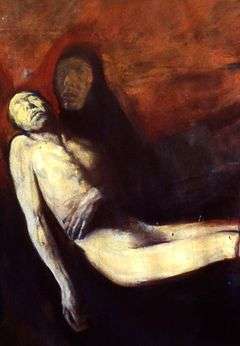
From then on he is only nominally a student; choosing his themes independently and working outside of the classroom that sophomore year with his sights on Rembrant and Titian while painting the first state of his mother's portrait Woman with Red Hands (1963) and Burial of Christ (1964) whose stark representation, an homage to the medieval Villeneuve-les-Avignons Pieta, is the first of a number of works made over the years where he portrays himself in the role of the alienated outsider.

These are followed in his junior year by the double-portrait of the actors Michael Tucker and Laurie Jefferson (1965) and his own partial Family Portrait (1965) that portrays only his mother, younger brother Ronald and himself during the highly emotional period when his parents have separated. Executed on rabbit-skin glue sized but not primed linen canvas, the faces in both paintings are built up from the absorbent weave that owe much to the example of Edgar Degas - especially that of the artist's mother to Degas' Portrait of a Young Woman (1867).
That summer of 1965, in Six Characters in Search (1965), the artist paints himself as rebellious protagonist/target of ridecule and prosecutor of judgment that takes its cue from Michelangelo's Christ in the Last Judgment; and senior year Jewess Accused (1965) which shifts emphasis in the story of "Christ and the Woman Taken in Adultery" to express the ostracism and accusation of crimes levied against the Jews that lead to the Holocaust. This is followed in his last semester by We Are All Somnambulists (1966). All of which are painted from live models.


However, Rappaport's work is out of phase with the dominant art movements emerging in the sixties: Pop Art, Minimalism, and Conceptualism, and at odds with New Realism whose program of objectivity in representing the human figure by eliminating all subjective response implying the spiritual dimension discredits the overt Romanticism in Rappaport's painting. Only Alice Neel and Larry Rivers in New York, Francis Bacon and Lucian Freud in England, and Balthus in France are privileged to paint figuratively with any response to an inner life given their subjects or any implied narrative. Consequently, Rappaport's practice is marginalized already as a student, and in these early works expressing universal themes of the human condition his painting takes on an autobiographical aspect.
Apart from painting, Rappaport is constantly drawing. His most evolved graphic series he does his sophomore year in a series of drawings, lithographs, and etchings executed directly from a theatrically lit display case at the Carnegie Museum of a naturally mumified skeletal figure buried in fetal position, which was already a fascination for the artist when a fifth grader at the museum's Tam-O'Shanter classes and to which, used as a symbolic motif of the Holocaust, the artist will return thirty-five years later in painting The Oven's Womb (1997), 119"x145", drawn in a simplified manner, as if cave painting, on a color field of cadmium red.
In the ground floor sculpture studios Rappaport regularly sees Jonathan Borofsky, who is a sculpture major two years ahead of him, and during his sophomore year becomes better acquanted with Mel Bochner, who having graduated five years before has returned to Pittsburgh for the year. As both come from the same neighborhood, Rappaport gives the older artist rides in the evenings to the campus where they work in the print room and from which Bochner often visits Robert L. Lepper in his studio just down the hallway and on returning shares his enthusiasm for Lepper's speculative conversations on art practice.
In the autumn of 1964, that following year, Rappaport takes Lepper's The Oakland Project and Retrospective classes, entitled "Individual and Social Analysis", and soon forms a close bond with the older man. However, while Rappaport is fascinated by Lepper's logic and eloquence on a broad range of perceptual and communicative issues; his direction cannot be categorized with that of Lepper's famous former students: Andy Warhol, Philip Pearlatein, Mel Bochner, and Jonathan Borofsky, who, made conscious of changing hierarchies of value due to the impact of the machine and media on society, are directly influenced by Lepper's work in industrial design and Bauhaus leanings addressing the potential of technology's role in contemporary art practice, which, along with Lepper's conceptual paradigm: communication as intention expressed and followed logically, leads to making art the focus for following human reason engaged in the perception of its own awareness - a strategy seen in Bochner's Conceptual practice.
Rappaport, as much as he remains devoted to Lepper for the next twenty-five years, and all the while following the progression of Lepper's ideas in the evolution of the above-mentioned artists' work, consequently leading to his writing in 1989 "Robert Lepper, Carnegie Tech, and the Oakland Project", cannot be considered in Lepper's "camp". (This will be made more evident some seventeen years after Lepper's death in his essay Robert Lepper / Six Characters in Search that reviews Lepper's legacy four decades later.)
Instead, Rappaport keeps to his own agenda, already evident in the Burial of Christ painted the year before meeting Lepper, which merges in expressive figurative painting the autobiographical with the socio-political, which are options in artistic direction laid out in Lepper's introduction to his classes, and exemplify the expressive force in what Lepper is pointing to in The Retrospective, whose primary goal, bracketed-off from the socio-political, evokes the emotive, psychic power of unmediated memory in response to autobiographical material.
Most importantly, Rappaport's departure in the late 1960s from traditional brush painting to his employing grattage technique does owe a debt to Lepper's own example of arriving at the conclusion that the paintbrush was not his tool but those of the industrial fabricator were. And in looking back to the great figurative tradition of western art as a resource and inspiration, Rappaport is doing so informed by Lepper's late-modernist/postmodernist perspective and his injunction to allow for the unexpected by letting the process suggest where the work should go and not rush to expectations that set limitations on expression.
The autumn of 1964 proves to be an auspicious time when soon after beginning Robert Lepper's class, Rappaport meets Herbert A. Simon, one of the most influential social scientists of the 20th century, whose computer simulated pioneer work in decision making parallels the communicative functions in Lepper's conceptual strategies, and following Rappaport's gift of a lithograph drawing of Simon's daughter Barbara, which initiates their acquantance, Simon becomes an early supporter and longtime friend of the young artist, and whose portrait Herbert A Simon (1987) Rappaport paints in the summer of 1987 for Carnegie Mellon University as its first Nobel Prize laureate on the faculty and which is followed a week later by Lepper's portrait.
Ship of Fools, July 1966

Upon graduation in June 1966, Rappaport is offered a loft space on West 74th Street, New York for the summer where he paints his first work that is no longer dependent on live models but instead employs an expressively gestural execution in drawing the figures with large areas of washed-on color. Taking a cue from a photograph of Chagall painting his murals for Lincoln Center on the floor, as well as Japanese scroll painting in a book left by his benefactor which includes an image of a typhoon swept boat in the Mongol armada's failed invasion of Japan in the sixteenth century, Rappaport, with Hieronymus Bosch's version already in mind for its subject, begins painting Ship of Fools (1966) within hours of the announcement of the United States first bombing raids into North Vietnam escalating the war.
Ship of Fools not only marks a major historical event; artistically it marks a turning point from which the twenty-one-year-old artist enters into the beginning phase of a four-year evolution towards an iconographic figuration that in some works of 1970 comes close to reducing traces of the figurative element almost entirely.
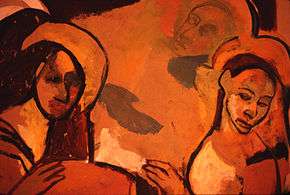
Rappaport's next major work in that evolution, the Oratory Mural (1966-1967), comes as a result of exhibiting Ship of Fools at Skibo Hall at Carnegie Mellon University in November 1966 when Father Philip Walsh of the Pittsburgh Oratory commissions Rappaport to paint a triptych for their proposed retreat house and arranges for the artist a studio space in the former chancellery behind St. Paul's Cathedral in Pittsburgh where the artist paints the canvasses on the floor in its Gothic library. The mural, declined, remains rolled for twenty years; whereupon, through the auspices of Michael A. Roosevelt, it finds a home on extended loan to the Institutes for the Achievement of Human Potential, Philadelphia in 1987.

In working out the iconography on this fourteen by twenty-five foot triptych, the artist becomes an admirer of the frescoes of Giotto; though only the "Escape through the Desert" on the left canvas of the Oratory Mural suggests openly that influence. And in general, in spite of the seriousness of the subject in Giotto's cycle on 'The Life of Christ" in the Scrovegni Chapel, there is a playfulness in the pantomime that informs its celebratory mood that Rappaport responds to in his mural and that is expressed in the decorative, modernist function of the gessoed patterns playing in tandem with the figurative representation.
On a structural level, it is in works a few years later, however hidden his example, where Giotto's condensed compositions within the square that collapse the architectural space, or as in the cycle on St. Francis in Assisi, the mountainous canyons in which his figures find themselves, that becomes a source of inspiration for Rappaport's more abstracted figurative works contained in shallow relief as in Valley of the Kings (1969) and Asleep by the Tomb (1970).
Giotto, however, is not alone as an iconographic source for the mural. In Robert Campin's Annunciation (1427-1432), the round table that discreetly separates the angel Gabriel from Mary becomes for Rappaport's image the "circle of acceptance" upon which Mary is about to place her hand, and where Rappaport adds above her head the face of another angel representing her consciousness of her son's future looking upwards to the Baptism, and from which evolves several years later into the surreal and abstracted motif of "courtship" in Providence in Motion (1969).
While working on the Oratory Mural, the artist having graduated, nonetheless, is given for a short time the privileged use of the print room at Carnegie Tech. Transcribing onto a large deeply bit etching plate a linear adaptation of his mother's portrait Woman with Red Hands (1963-1966), the artist fashions a severe icon of his mother which when combined with the motif in the etching of Evelyn Ress, with the double view of her head one dropping below the other as she falls asleep, becomes the prototype for a series of paintings that start with Mourning Clown (1967), that expresses the artist's sorrow over the death of his good friend Mrs. Ress, and The Work of Mourning (1968), that turns to the greater theme of the Holocaust, and which make a seamless progression into the works that evolve in France in the autumn of 1968.
The Paris Years: Iconic Abstractions, Joseph Accused
In September 1968, upon being awarded the Chaloner Prize through the Rome Prize competition, Rappaport begins what would be an almost three-year sojourn in France; first living in Vincennes and the following year, through the auspices of Darthea Speyer, the American-in-Paris gallerist, is awarded a residency at the Cite Internationale des Arts.

Although Picasso's Weeping Woman is suggested in these works in Paris, as is Tutankhamun's gilded face mask and Rouault's The King, in Biafran Madonna 1st ver. (1968) and Rabbi (1968), along with the formal structure in the Romanesque altarpieces of Cimabue in Father, Vulture, Holy Butterfly (1968), and the paint-encrusted shield-like shapes of Oceanic effigies in Death Has No Master (1970); it is his own etchings, and above all, the etching process itself: from rolling a coating of wax onto the plate's surface - to drawing into that wax ground - to scraping away unwanted lines after the plate is bit in the acid bath that leads Rappaport to the way he will soon execute in paint in a two-stage process the works of 1969 and 1970 that are shaped by scraping away the multiple layers of paint applied in the initial stage of the image both when malleable and once dry to form reductively the final image - a process to which the artist gives the general term "in grattage". As such, the tactile, almost violent manner, in the acknowledgment of process and material in forming these primitive/modernist figurative icons which are as much carved and sculpted as painted and the resulting symbolism that explores the devastation of time upon man's endeavors or portrays malevolence against the innocent anticipates Neo-Expressionism and relates to the work of Anselm Kiefer.

Two years later in the autumn of 1970, while his solo exhibition of the more recent of these "iconic abstractions" is hanging at the Cite des Arts, Rappaport, upon reading Thomas Mann's "Joseph and His Brothers", begins Joseph Accused (1970-1971) followed by Joseph in the Pit (1971) and Jacob in Mourning (1971) which are made in a scratchboard-like technique in which the drawn image is scratched through the dry surface layer of cadmium red into the base layers of turquoise and yellow-white on the canvas - a method to which the artist also gives the term "grattage", and which its effect in Joseph Accused suggests ancient Egyptian temple wall reliefs precisely cut into red granite in which the figures are styled as a consequence in shallow space, deliberately flattened and silhouetted by overstated contours.
The ritualized gesture of Joseph's arms extending downwards, as if bound together to two open hands, a sign of supplication and innocence, is a studied and mimetic quotation. This combined with the addition of the second arm and hand is an obvious restructuring of the desperately outstretched arm and hand of the man being strangled in Max Beckmann's Die Nacht, which Rapport sees as a symbolic precursor to "Kristallnacht", the Nazi "Night of Broken Glass", the night of terror perpetrated on the Jewish community on November 7, 1938, generally considered marking the beginning of the Holocaust. Consequently, Rapport considers his representation of the Biblical story of Joseph Accused, with its formalistic and iconographic pictorial dependency on the art of Max Beckmann, as an iconographic statement for modern history to the horrific anti-Semitism in Nazi Germany and a testimony to the theme 'stranger in a strange land' in Thomas Mann's four book epic honoring the ancient Hebraic spiritual quest.
The New York Years, Portraits in Grattage, The Public Theatre Hangings
Throughout most of the 1970s, while simultaneously painting works that have evolved from the iconic abstractions of Paris, Rappaport makes over twenty portraits in grattage beginning with the double portrait of Jake and Esther Schwartz (1971) in Philadelphia while staying at his brother's on his return from France in the summer of 1971 for the sculptor Barbara Schwartz, the model for Potiphar's Wife in Joseph Accused; then once in New York, Luke (1973) that will be shown along with works by Warhol and Philip Pearlstein in New York City / Carnegie Mellon Alumni exhibition at Westbroadway Gallery in 1976, the tapestry-like devotional icon of the guru Baba Muktananda (1976-1977), and its technical twin: The White Sisters (1976-1979), that evolves through several metamorphosis, then finally scraped-down to a bare tint of color on the canvas threads leaving only the lyrical contours as an Art Nouveau tableau, finished just months before the artist's return to traditional brush painting with The Barren Womb (1979).
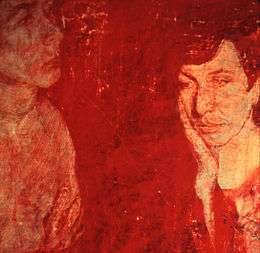
But before his New York period begins, the artist is stricken and operated for pericarditis in the spring of 1972, spending most of the summer at his brother's in Philadelphia convalescing before needing a second operation in early September. Then two theatre friends of his brother's from the Carnegie Tech Drama Department invite the artist to New York by commissioning their portraits in grattage. The first, the double portrait of Jack & Richard (1972) of the stage designer Jack Doepp and aspiring opera singer Richard Magpion is made during the artist's stay at Jack's studio on West 85th Street for the remainder of the year and owes the decorative aspect and theatrical staging of the two figures emerging from the densely luminous red surface to Gustav Klimt's gilded paintings. The portrait, nonetheless, is declined and five years later in 1977 is purchased by Pamela Newhouse. The second, the more sober portrait of Dean Brown (1973), is finished that spring when the artist moves to East Seventh Street in the East Village, Manhattan.

In 1974, at the home of Conde Nast publisher S.I. Newhouse Jr., Rappaport is introduced to Joseph Papp, the founding director of the New York Public Theatre, who offers to hang the nine feet high Joseph in the Pit and Jacob in Mourning in the Public Theatre's inner-lobby. They are installed that autumn of 1974 and remain there till the autumn of 1977.
Soon after their return the artist reworks Joseph in the Pit painting Joseph's hand red to stand for the painting of blood on the doorposts as a sign to warn away the Angel of Death in the Passover story of "Exodus", compounding it with the original story in "Genesis", and adding the huge face of a female apparition, suggesting that angel, drawn from the portrait Catherine Kirkwood (1977), that, with the artist being the model for Joseph, adds an autobiographical layer to this episode of Joseph's struggle with self-doubt that prefigures the story of Jesus in the New Testament's "Christ on the Mount of Olives". In this, Rappaport follows the Western art practice of the continuous narrative - the layering of stories separated by centuries while alluding to stories further into the future.
Attacked late at night by a knifer while walking through Tompkins Square in the East Village in early 1978, Rappaport, shaken by the incident and discouraged after his paintings are taken down at the Public Theatre, abandons his apartment on East Seventh Street and spends more than several months in Washington, D.C. before moving to Brooklyn in 1979 when he enters the masters program at Brooklyn College with the thought of eventually teaching, earning his M.F.A. in 1981.
Given a portion of his modest inheritance when his father is stricken by a major heart attack, Rappaport begins in the December 1981 issue of Art in America his first suite of multiple ad pages that continue in the following issues through April 1982. Coinciding with that last issue in April, Rappaport stages an exhibit in a carriage-house studio at 29 Downing Street in the West Village (NYC), of seven current paintings including The Abode (1981) and White Madonna (1981) attracting Judd Tully, who intrigued by Rappaport's independent media campaign, includes mention of it in his review for that summer's issue of Flash Art International.
Two years later Rappaport joins the cooperative Blue Mountain Gallery in New York where he has five solo exhibitions through 1991.
The Return to Pittsburgh, A Visit to Paris: The German Girl
In 1985 he returns to Pittsburgh. Then after a series of seven self-portraits made in the summer of 1986, a number of which are shown with Blue Madonna (1986) at Blue Mountain Gallery towards the end of that year; that following summer, upon being commissioned by Herbert Simon to paint his official portrait for Carnegie Mellon University, the artist also begins a series of elders and former teachers which includes that of Robert L. Lepper (1987), writing in 1989 Robert Lepper, Carnegie Tech, and the Oakland Project as a tribute to his former teacher who leaves a copy of it with his papers in the Carnegie Mellon University faculty archives.
A short three-month sojourn to Italy in late summer of 1989 provides the artist the occasion to leave the expressionism of Buddha from the Cross (1989) and Red Ashen Skies (1989 / 2010) painting two works that restate in a more traditional manner standard Renaissance themes: the first, a baptism, later renamed Narcissus (1989 / 2007) painted in Florence in August and September and followed that October in the Sienna countryside with an Expulsion from the Garden (1989 / 1992). Both early states of these works are shown in the artist's last exhibition at Blue Mountain Gallery in New York in late December 1990 into early January 1991.
After a romantic encounter in April 1994 while visiting friends in Paris, the artist returns to France that autumn moving into a garden studio in Vincennes for ten months; there painting in a rite of exorcism the self-portrait: The Performer (1994) as counterpart to the series of single female nudes: The German Girl which owe their eroticism to the example of Egon Schiele but without the latter's explicitness. An exhibition of these paintings is shown as "La noia alemanya nua" at Galeria Magdalena Baxeras in Barcelona in December 1995 following an introduction by the Cuban photographer Herman Puig, who, having photographed Rappaport in the Vincennes studio, has invited the artist to visit Barcelona. Four of Puig's photographs of the artist sitting by his paintings are reproduced on advertisement pages in the Flash Art November/December 1995 issue and in Artforum in the November 1995, December 1995, and January 1996 issues announcing the Barcelona exhibition. These independently produced reproductions begin a new cycle of the artist's ad pages as exhibition site that run till 2003 in some thirty issues of these and other international art journals that include multiple page presentations in Bomb, Modern Painters, World Art, and Limn.
Ashes in the Wind: The Work of Mourning: A Commemoration
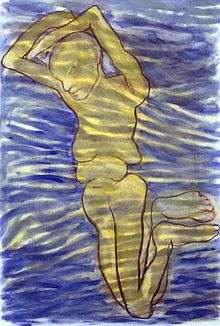
Then continuing painting in a similar manner, the artist once back in Pittsburgh changes themes painting iconographic images of individual female figures symbolic of the victims of the Holocaust: Ashes in the Wind (1996), Madonna of the Flames (1996), Schneeloch (1996), Freeze (1996), The Chamber (1996), and Furnace Dancer (1997); and from there shifting to the motif of the skeletal figure buried in fetal position that the artist had drawn when a sophomore at Carnegie Tech and now drawn in a manner that suggests cave painting on very large canvasses washed in cadmium red in The Oven's Womb (1997).
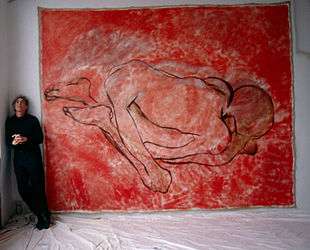
Then following 9/11, in the December 2001 issue of Artforum Rappaport places on an ad page a photograph from 1966 with himself standing by Ship of fools (1966) with a caption ending in "It was a time when dossiers were made on anyone who openly had concerns about our foreign policy." addressing the historical parallel with the proposed restrictions on free speech and debate as the country prepares for war.
In its September 2002 issue, Artforum prints Rappaport's letter-to-the-editor responding to Linda Nochlin's review Mirroring Evil: Nazi Imagery / Recent Art, published in the Summer 2002 issue on the exhibition of the same held at the Jewish Museum in New York.
In 2004 Rappaport begins writing his Memoir Portraits & Passages which goes on-line in late August 2005.
In February 2005 within two weeks of the 60th anniversary of the liberation of Auschwitz, Rappaport exhibits the Holocaust images from 1996 and 1997 in Ashes in the Wind: The Work of Mourning at Garfield Artworks in Pittsburgh.
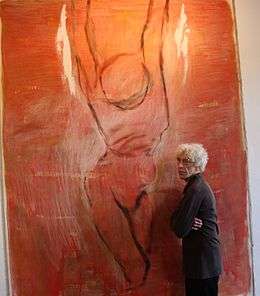
The artist continues this theme four years later in paintings suggesting crucifixions drawn in the manner of Michelangelo's conceptual sketches on the subject - but here the male figures are without crosses, nine feet high on washes of cadmium red in To Leap into the Arms of the Eternal (2009), and Lightning on Sinai (2010), and in the striated washes of Storm Swept (2011). Though formally iconographic, unlike the ironic detachment prevailing in Postmodern pastiche and parody, they are set at no psychological distance from the viewer and instead call for a meditative and empathetic response. Such a commemoration for the victims of Nazi hatred, stretching back forty-five years to Jewess Accused (1965), here painted with reticence and deep respect for the human being, is a parallel expression to the works addressing the disastrous consequences of barbarity as seen from the opposite side of that dark history: those of Anselm Kiefer.
Although one might wish to make a categorial statement on Rappaport's work, given its emotional undercurrent, its often painful subject-matter and expressive execution; it may be incorrect to place the whole body of work solely on the expressionist side of the Classical/Romantic divide without acknowledging that in his work as a whole there is a strong sense of formal structure and a tendency towards finding equalibrium that plays a reciprocal and balancing role to the more expressive dynamic. And this may explain its spiralling evolution; whereupon, once reaching a saturation of effect in a period of work, the artist returns to a grounding in order, simplicity, and coherence, and always with reverence for the dignity of the body and nobility of the human face.
A more complete catalogue of Rappaport's work can be found on Wikimedia Commons.
Awards and Exhibitions
- 1962 - Scholastic Art & Writing Awards,[2] the National Gold Medal in Drawing.
- 1966 - Solo Exhibition at Skibo hall, Carnegie Mellon University.
- 1967 - Solo Exhibition of the "Oratory Mural" at Skibo hall, Carnegie Mellon University.
- 1967 - Solo Exhibition at the University of Chicago - Lexington Studio Gallery, Chicago.
- 1968 - The Chaloner Prize,[3] as a finalist in the American Academy in Rome Prize Competition.[4]
- 1969 - Group exhibition, "Jeunes artistes americans" at le Centre Cultural Americaine, Paris.[5]
- 1970 - Solo exhibition at le Cité Internationale des Arts, Paris.[6]
- 1974 - 1977 Installation - "Joseph in the Pit", "Jacob in Mourning", the Joseph Papp Public Theater, New York
- 1974 - Solo Exhibition - South Houston Gallery, SoHo, New York.
- 1976 - "Carnigie Mellon/NYC Alumni Show", West Broadway Gallery, SoHo, New York.
- 1982 - "29 Downing Street", New York City[7]
- 1983, 1984, 1986, 1989, 1991 - Solo exhibitions of paintings at the Blue Mountain Gallery, SoHo, New York City.[8]
- 1987 - Installation of the "Oratory Mural" on extended loan to the Institutes for the Achievement of Human Potential, Philadelphia.[9]
- 1995 - Solo exhibition - "The German Girl Nude" ("La noia alemanya nua") at Magdalena Baxeras Galleria d'Arte, Barcelona
- 1997 - Group exhibition "Go Figure" at the University of Rhode Island, Kingston.
- 2005 - "Ashes in the Wind: The Work of Mourning", Garfield Artworks, Pittsburgh.[10]
- 2007 - Group exhibition, "Garden Show: In Full Bloom" Space Gallery, Pittsburgh.
- 2011 - "Rappaport Unblurred", International Children's Art Gallery, Pittsburgh.
References
- ↑ "Robert Lepper, Carnegie Tech, and the Oakland Project". Worldcat.org. Retrieved 2013-10-05.
- ↑ "National Scholastic Art & Writing Awards". Artandwriting.org. Retrieved 2013-10-05.
- ↑ "Chaloner Prize". Siris-archives.si.edu. Retrieved 2013-10-05.
- ↑ "American Academy in Rome". Aarome.org. Retrieved 2013-10-05.
- ↑ Service Americane d'information et des relations cultural, "Jeunes Artistes American", review of same, Informations & Documents, 15 October 1969: 20
- ↑ "Le Cite Internationale des Arts". Citedesartsparis.net. Retrieved 2013-10-05.
- ↑ Judd Tully, "Richard Rappaport, 29 Downing St." review of same, Flash Art International, no. 108 (Summer 1982).
- ↑ "Blue Mountain Gallery". Blue Mountain Gallery. 2013-01-25. Retrieved 2013-10-05.
- ↑ "iahp.org". iahp.org. Retrieved 2013-10-05.
- ↑ "Works of Mourning, review of same, The Jewish Chronicle 3 February 2005". Pittchron.com.
External links
| Wikimedia Commons has media related to Richard Rappaport. |
- Rappaport’s website, "Portraits & Passages," is his memoir illustrated by his works.
- Article in Pittsburgh City Paper, on exhibition at International Children's Art Gallery (July 21, 2011) - Venerable painter Richard Rappaport discusses five of his works.
- Article in Portuguese Wikipedia: "Pintura nos Estados Unidos", surveying painting in the United States from colonial times to the present, citing Rappaport's work along with that of two older artists as "good examples of the persistence of expressive figurative painting during its phase of ostracism and its recovery in the mid-1970s" and including reproductions of Jewess Accused (1965) and Self-Portrait (1986): "Philip Guston, Richard Rappaport e Chaim Goldberg sao bons exemplos da persistencia da pintura figurativa durante sua fase de octracismo e de sua recuperacao em meados dos anos 1970."
- For a gallery of Rappaport's work on Wikimedia Commons click here. Also included is commentary about the work on the Discussion tabs.